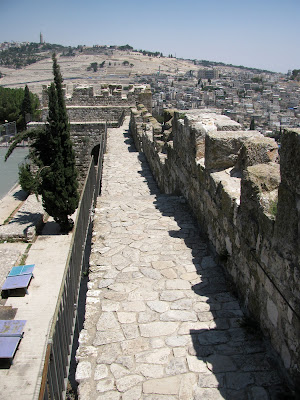Back in 2012 we walked the northern section of Jerusalem's Old City walls. We didn't have time to go south towards the Western Wall that day but it was in my mind to do so. A few weeks ago we made a return visit to complete the circle.
The Ramparts Walk is a great way to see Jerusalem from a different perspective and to peek into places that you would otherwise never see. The present walls were built by Suleiman the Magnificent in the 16th century, when he restored the ancient walls of the city, and they have served as military fortifications ever since. From 1948 to 1967 Jordanian snipers used the ramparts as a vantage point from which to shoot at Israelis living outside the Old City. You can still see bullet holes on many of the older buildings facing the Old City.
The walk along the southern walls took us from Jaffa Gate to Zion Gate and let us off near Dung Gate, not far from the Western Wall Plaza and the Jewish Quarter. On one side of the wall we could see inside the Armenian Quarter, the smallest quarter of the Old City which houses the smaller Armenian Compound that is private and gated, and from the other we enjoyed panoramic views of modern Jerusalem including Yemin Moshe, the King David Hotel and behind it the tip of the YMCA tower.
As we walked around the walls we could see the Armenian Theological Seminary, the cemetery of Dormition Abbey and the Church of St. Peter. The stables of the Israeli Police surprised us (picture no.3). Known as the Kishle, from the Turkish word for barracks, they were built by the Ottomans in the 19th century on the site believed to have housed King Herod's magnificent palace 2,000 years ago. Arranged around a large courtyard they currently house police offices, stables and guardrooms.
Continuing on we soon had a good view of the Mount of Olives, Har HaZeitim. It is named for the olive groves that once covered its slopes and has been used as a Jewish cemetery for over 3,000 years. It is also described in the New Testament as the place from which Jesus ascended to heaven.
We saw the Arab neighbourhood of Silwan which is built into the southern slope of the Mount of Olives. Silwan derives from the Greek "Siloam", which comes from the ancient Hebrew name "Shiloah", the name of a pool in the area used to collect water from the Gichon Spring, the chief water source of ancient Jerusalem. Shiloah makes several appearances in both the Hebrew Bible and the New Testament. The roots of the modern village were put down in 1882 by Yemenite Jews but it became entirely Arab after the Arab Riots of the late 1930's. Political tensions are still high.
Descending to the Dung Gate, we had just a short walk to the Western Wall, HaKotel HaMa'aravi. The last remnant of the ancient wall that surrounded the Holy Temple's courtyard, it is the most significant site in the world for the Jewish people. Traditionally people write notes to God and place them between the ancient stones of the Wall. After a morning steeped in history we had time for a short prayer and then a return to modern times with delicious pizza in the Jewish Quarter. The wall climbing had made us all hungry!



































3 comments:
The Ramparts Walk look amazing Lisa! Such a cool way to see the city. It must be a treat to visit ancient places like this.
Thanks for letting me know about this Lisa! I have just read your entire blog post to my husband and shown him the pics. It is exactly the same walk we did. Brought back lovely memories!
I remember feeling the same as you said - like we got views into parts of Jerusalem that we would never normally have seen.
Your pic with the view of the Mount of Olives was where we had seen the Bar Mitvah Procession a few days earlier.
Thanks so much for this!
so much history! I visited this area twice many years ago - but its so lovely to see your photos! Thanks for taking us on your journey!
Post a Comment